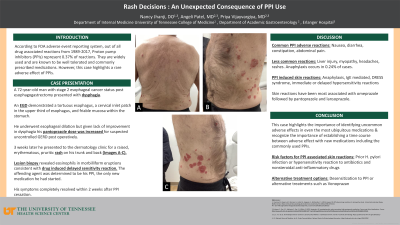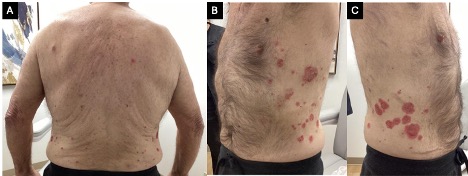Monday Poster Session
Category: Esophagus
P2316 - Rash Decisions: An Unexpected Consequence of PPI Use
Monday, October 28, 2024
10:30 AM - 4:00 PM ET
Location: Exhibit Hall E

Has Audio

Nancy Jhanji, DO
University of Tennessee HSC COM Chattanooga
Chattanooga, TN
Presenting Author(s)
Nancy Jhanji, DO, Angeli Patel, MD, Priya Vijayvargiya, MD
University of Tennessee HSC COM Chattanooga, Chattanooga, TN
Introduction: Proton pump inhibitors (PPIs) are used to treat GERD, peptic ulcers and Barrett’s esophagus and they inhibit gastric acid secretion by blocking the H/K ATPase pump. PPIs are well tolerated but can uncommonly have side effect of skin reactions. Of which, angioedema/urticaria are most frequent. Anaphylaxis occurs in 0.24% of cases. PPIs are commonly prescribed medications and this case highlights a rare adverse effect of PPIs.
Case Description/Methods: 72 year old man with history of stage 2 esophageal cancer status post esophagogastrectomy presented for dysphagia. EGD showed tortuous esophagus, a cervical inlet patch in the upper third of esophagus, and friable mucosa within the stomach. He underwent esophageal dilation but given lack of improvement in dysphagia his pantoprazole dose was increased for suspected uncontrolled GERD post surgery. He then presented to dermatology clinic for a raised, erythematous, pruritic rash on his trunk and back (Image 1). Lesion biopsy showed eosinophils in morbilliform eruptions consistent with drug induced reaction from PPI, the only new medication he had started. His symptoms resolved within 2 weeks after PPI cessation.
Discussion: According to FDA adverse event reporting system, out of all drug associated reactions from 1989-2017, PPIs represent 0.37% of reactions. Patients typically experience mild adverse effects such as nausea, diarrhea, constipation, and abdominal pain. Less commonly, PPI are associated with liver injury, myopathy, headaches and rashes. PPI induced skin reactions can manifest as anaphylaxis, IgE mediated, DRESS syndrome, immediate or delayed hypersensitivity reactions. This patient’s symptoms presented 3 weeks after drug initiation correlating with delayed hypersensitivity reaction. Skin reactions have been most associated with omeprazole followed by pantoprazole and lansoprazole. In cases similar to this patient, desensitization to PPI or alternative treatments such as vonoprazan may be more suitable. This case highlights the importance of identifying uncommon adverse effects in even the most ubiquitous medications, as well as to recognize the importance of establishing a time course between adverse effect with new additions to patients’ medications including the commonly used PPIs. Prior H. pylori infection or hypersensitivity reaction to antibiotics and non steroidal anti inflammatory drugs may be a risk factor to skin reactions to PPIs. Counseling patients on such effects increases their awareness to seek immediate medical attention.

Disclosures:
Nancy Jhanji, DO, Angeli Patel, MD, Priya Vijayvargiya, MD. P2316 - Rash Decisions: An Unexpected Consequence of PPI Use, ACG 2024 Annual Scientific Meeting Abstracts. Philadelphia, PA: American College of Gastroenterology.
University of Tennessee HSC COM Chattanooga, Chattanooga, TN
Introduction: Proton pump inhibitors (PPIs) are used to treat GERD, peptic ulcers and Barrett’s esophagus and they inhibit gastric acid secretion by blocking the H/K ATPase pump. PPIs are well tolerated but can uncommonly have side effect of skin reactions. Of which, angioedema/urticaria are most frequent. Anaphylaxis occurs in 0.24% of cases. PPIs are commonly prescribed medications and this case highlights a rare adverse effect of PPIs.
Case Description/Methods: 72 year old man with history of stage 2 esophageal cancer status post esophagogastrectomy presented for dysphagia. EGD showed tortuous esophagus, a cervical inlet patch in the upper third of esophagus, and friable mucosa within the stomach. He underwent esophageal dilation but given lack of improvement in dysphagia his pantoprazole dose was increased for suspected uncontrolled GERD post surgery. He then presented to dermatology clinic for a raised, erythematous, pruritic rash on his trunk and back (Image 1). Lesion biopsy showed eosinophils in morbilliform eruptions consistent with drug induced reaction from PPI, the only new medication he had started. His symptoms resolved within 2 weeks after PPI cessation.
Discussion: According to FDA adverse event reporting system, out of all drug associated reactions from 1989-2017, PPIs represent 0.37% of reactions. Patients typically experience mild adverse effects such as nausea, diarrhea, constipation, and abdominal pain. Less commonly, PPI are associated with liver injury, myopathy, headaches and rashes. PPI induced skin reactions can manifest as anaphylaxis, IgE mediated, DRESS syndrome, immediate or delayed hypersensitivity reactions. This patient’s symptoms presented 3 weeks after drug initiation correlating with delayed hypersensitivity reaction. Skin reactions have been most associated with omeprazole followed by pantoprazole and lansoprazole. In cases similar to this patient, desensitization to PPI or alternative treatments such as vonoprazan may be more suitable. This case highlights the importance of identifying uncommon adverse effects in even the most ubiquitous medications, as well as to recognize the importance of establishing a time course between adverse effect with new additions to patients’ medications including the commonly used PPIs. Prior H. pylori infection or hypersensitivity reaction to antibiotics and non steroidal anti inflammatory drugs may be a risk factor to skin reactions to PPIs. Counseling patients on such effects increases their awareness to seek immediate medical attention.

Figure: Rare skin rash following pantoprazole initiation
Disclosures:
Nancy Jhanji indicated no relevant financial relationships.
Angeli Patel indicated no relevant financial relationships.
Priya Vijayvargiya indicated no relevant financial relationships.
Nancy Jhanji, DO, Angeli Patel, MD, Priya Vijayvargiya, MD. P2316 - Rash Decisions: An Unexpected Consequence of PPI Use, ACG 2024 Annual Scientific Meeting Abstracts. Philadelphia, PA: American College of Gastroenterology.
